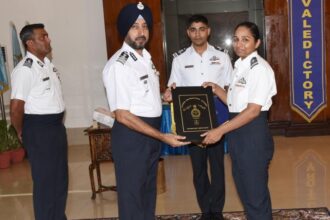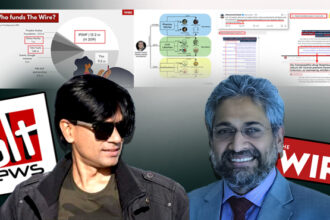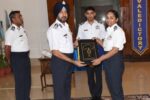Clashes broke out between two groups of students at the Jawaharlal Nehru University (JNU) campus, New Delhi, during the Dussehra celebrations and during a ‘visarjan’ (immersion of the idol) procession to mark the culmination of the Durga Puja celebrations, on Thursday. The RSS-affiliated Akhil Bharatiya Vidyarthi Parishad (ABVP) and the Left student groups accused each other of causing disturbances. A peaceful procession — the “Visarjan Shobha Yatra” — was underway when the clash occured and caused disruptions.
In a statement to the media, General Secretary, JNUSU, accused the ABVP of spreading disharmony at the campus and the society, weaponizing politics, criminalizing dissent, curbing minorities and their right to dissent at the campus. She accused the ABVP of instigating the Left groups and of “trying to feed the security guards sweets”.
On the other hand, students of the ABVP have said that the decision for the burning of effigies was meant to be a symbolic act against Maoism and Naxalism. Students of the Left groups gave a collective call against the announcement of the burning of effigies and called their actions “resistance” against “politics of hatred”.
This is not the first time in recent years that the Durga Puja or the devotion for Durga has been found at the core of the clash of ideas tilting towards disruptions — from debates and disagreements. In 2022, Ram Navami celebrations during the Chaitra Navratra turned violent at JNU — with students of the ABVP and the JNUSU levelling accusations of stone- pelting on each other. The issue was the distribution of non-vegetarian food at a hostel. In the past, ABVP has opposed the reclamation of Mahishasur as a heroic figure at the campus
as supported by a section of students at the campus and sections of the media.
The official statement issued by JNUSU on October 2 was titled “Reject ABVP hate politics”. During the last two decades, several incidents of protests and “resistance” involving the Left student-groups at JNU have set the tone for the Left’s agenda at the national front or have been led by students from the university. These have been reported by the different sections of the media over the years and their impact has been stated by leaders of the Left student groups themselves.
As is the norm, JNUSU leaders representing the Left student groups have pointed to “Jai Shri Ram jaise naare” (slogans such as “Jai Shri Ram“) raised by the ABVP.
At the same time, statements issued by the Left student groups or the Left-dominant JNUSU display indications of the direction their “resistance” would take within or outside the campus — over the coming months and years. Some important highlights from the statement issued by the Left-dominated JNUSU on the October 2 incident:
The statement says that the ABVP once again exposed its communal agenda by staging Ravan Dahan in which former JNU students Umar Khalid and Sharjeel Imam were depicted as Ravan. It says (in bold letters) that “their cases are still under trial, and bail has been repeatedly denied on flimsy ground.” It adds that the “ABVP chose to hold a public trial on the streets.” The statement says that ABVP “could have shown Baba Ram Rahim…”. It adds that “they could have shown BJP leaders Anurag Thakur and Parvesh Verma, who incited the Delhi riots of 2020, but still enjoy impunity.”
It says (in bold letters) that RSS and BJP have a long record of weaponsing religion against political opponents. As a voice of the Left, it says that “we answered this hate with peace. We called for a protest demonstration against the politically motivated Ravan Dahan organised by the ABVP”. It accuses “ABVP lumpens” of having “responded with abuse”.
It urges students and citizens to expose the “politics of hate” and defend harmony on campus and beyond. The JNUSU has rejected claims that they opposed Durga Puja at the campus. The statement of the top member of the JNUSU reveals more interesting aspects. It is seen that the intensifying of accusations from the Union has been not only against the ABVP, but also the RSS, and leaders of the BJP.
In the above statement, JNUSU president Nitish Kumar says that the ABVP did not choose to burn the effigy of Nathuram Godse, but of constitution defenders and human rights defenders. According to him, the decision to “resist” the burning of the effigies was made to “reject the mentality”.
Nitish Kumar mentions in the statement that a poster emerged in the morning — pointing to the burning of effigies of two students. Kumar describes the two “students” as those who prepared and propelled a movement to “save” the citizenship of the nation, across the nation. He added that JNU will respond against it, as it is about those students who made possible the movement on CAA and NRC. In this statement, the use of “JNU” and not “JNUSU” in the context of “responding against” is noticeable, just as the use of “on” instead of “against CAA and NRC”, is. This is a shift in the Left’s stance.
The call of Ravana Dahan came from Vaibhav Meena. The effigy, said a post from Meena’s X account, “marked the symbolic destruction of anti-national elements represented by figures like Umar Khalid,
Sharjeel Imam, Afzal Guru, Charu Mazumdar, Basava Raju, and Kanu Sanyal, marking their end.”
The ABVP has single representation in the JNUSU. While JNUSU president Nitish Kumar comes from the All India Students’ Association (AISA), vice president Manisha and secretary Munteha Fatima represent the Democratic Students’ Front (DSF). Vaibhav Meena, the joint secretary, belongs to the ABVP. Meena comes from a family of farmers, in Rajasthan’s Karauli district, is a PhD scholar, and brought the ABVP to JNU’s central panel after a long gap of almost a decade.
Meena’s victory in the poll was more than a personal breakthrough. It brought relief to the ABVP in the midst of the alliance of AISA and DSF and in the ABVP’s own breakthrough performance at schools dominated by the Left. In the central panel dominated by the Left in a Left-dominated university, Meena’s goal was to make JNU better for students as he believed that the Left, during its years of dominance, has not been able to improve things, including the “deshdrohi” perception that the university has earned, which, according to him, is the result of the domination of the Left student groups.
A day after clashes, the campus seemed calm. Senior students representing the ABVP were busy wrapping up the Durga Puja and Dusshera celebrations-related work at the campus. Among them, Vikas Patel, a PhD scholar from eastern Uttar Pradesh, mentions ABVP’s growth at the campus as one of the factors contributing to the change in intensity of resistance from the Left.
According to him, the Left student groups are in “baukhlahat” (panic driven restlessness) because the JNUSU election is due in November. “They want to polarise. They want to show their activity on campus. They had come to oppose the effigy burning, but what they did was unfortunate — looking at the auspiciousness and the presence of the idol of Ma Durga. The JNUSU members took the lead in the matter. They are not getting media attention, maybe they wanted some. It is the 100th year of the RSS. That could be another reason contributing to their stance,” says Patel.
Rajeshwar Kant Dubey, a senior member of the ABVP and a PhD scholar believes that the Left is factually wrong and their hypocrisy on the constitution is coming to the fore. “ABVP stands for what is right for the campus, for JNU, for the nation and for the nation’s sovereignty. They panic when their selective agenda begins to break. For example, celebrating our cultural facets was not an aspect that people were open about. Aap tilak lagaa ke haathon mein kalawa pehen ke nahin ja sakte thhe (one would not be able to apply the tilak or wear the holy thread on the wrist to classes). Now, it’s changing.”
He suggests that while students begin to embrace their own culture and connect with their own belief system, and cultural nationalism, a shift is felt at the campus. What is the shift? Dubey says: “They (students in general)
will start questioning the propaganda that they have been consuming through academia and the Left ecosystem.”
On the “politics of hatred” accusations of the Left student groups, Dubey says: “earlier the academia and the media were 100 per cent controlled by the Left. Anything spoken by the Left was spoken until it was perceived and accepted as truth. With access to social media, people are now questioning them. Earlier JNU had a single voice — the voice of the ‘red’. Now, the campus has student-groups affiliated to regional parties, and they speak, they have a say in matters.”
Patel reflects on the efforts made by the ABVP students and the Durga Puja Samiti at the campus in the making the celebrations a success with a sense of pride. According to him, the number of students across ideologies,
representing different states and spoken languages attending the Puja celebrations this year was bigger than last year. “The celebrations are not held by the ABVP. It is the hard work of the Durga Puja Samiti which is supported by students and JNU alumni.”
One might wonder how many people visited the Durga Puja pandal this year during the Mahanavmi celebration (the ninth Navratra) at the JNU campus? “Last year, we counted 6,000, and this year, the number was higher, and we are yet to arrive at the count. The way we compute it is through the plates of the auspicious meal
served on the occasion,” Patel adds.
The point Patel makes regarding the increase in numbers: the soaring response to festivities associated with Durga Puja at the JNU campus this year. “They (students of the Left) are perhaps looking at the increase in the students’ presence at the Durga Puja celebrations this year and are not happy about it.”
Patel explains that the Durga Puja Samiti at the campus is a non-political organisation, but the participation of students representing the ABVP is more than others, because of the ABVP’s faith in the Devi. They take the lead in the celebrations and the ‘visarjan’ procession that covers a major part of the campus while doing prasad-distribution with a feeling of oneness and devotion. “This time, when the visarjan-related procession was at the
Sabarmati T-point (a point near the Sabarmati hostel at the JNU campus), students of the Left groups who were present to resist the call against the burning of the effigy, raised some slogans. Students in the ‘visarjan’ procession raised the slogans of Durga. The matter escalated after an exchange of gestures from the Left.”
According to Patel, the ABVP will release a statement relating to the clash. “The Durga Puja Samiti is a non political organisation and it is yet to issue a statement. They (Durga Puja Samiti) think that there should be tolerance for the festivities related to Durga Puja at the campus where festivals related to other faiths are celebrated with the same spirit and are open to all.”
The situation required segregation of issues, according to Patel. He mentions the apolitical character and independent stance of the Durga Puja Samiti. According to him, Left’s disagreement with a political stand taken by a section of students should have not been mixed with the celebration of the “visarjan“. “They should have taken it up separately. It was a matter between organisations and the Durga Puja Samiti had nothing to do with it. Take the political fight to the political arena. Aap unse ladiye, unse behes kariye, unse resistance show kariye (fight and argue with them, show them your resistance).”
The burning of effigies, according to students of the ABVP is about opposing ideas – like Maoism and Naxalism. “It is not against people.”
Patel mentions that the shrinking of the Red Corridor due to the efforts of the Centre, has led to the destruction of the Left’s narrative of the Left at the JNU campus. “It has impacted their energies. People have become more aware at the campus. The Left’s narrative and people related networks have broken within the campus – thanks to the breaking of their narrative on social media and the continuous work of the ABVP at the JNU campus. Things have changed in the classroom. Pehle aap class mein raksha sootra bhi nahin baandh kar ja sakte thhe (previously, it was tough to wear the holy thread on the wrist to the classroom). Things are changing and moving towards a balance at the campus.”
Some aspects in the larger picture:
1) there is continuing consistency in the pairing of the word “lumpens” and “ABVP” in the political vocabulary of the Left student-groups and their attack on the RSS.
2) Disruption during the celebration or culmination of a Hindu festival at a university campus — stands out as an incident in JNU’s localised context.
3) the continuing clash between the ABVP and the Left students’ groups on issues of culture that are Indic in nature, celebration, belief and vibrant campus life.
4) there is clarity in the stance of the ABVP regarding the “politics of prabhav” (effective work and actions) versus the politics of abhav (lack of things and scarcity). ABVP accuses the Left-dominated JNUSU and politics of delivering the politics of abhav. For the ABVP, Indic culture counts as a deliverable and factor in “politics of prabhav.” The assertion of the Left student groups on their own role towards maintaining “harmony” or “harmonious” at the JNU campus. They accuse the ABVP of politics of hatred.
5) The ABVP, during the last two decades, has continued to unapologetically assert its stand on what and who it considers “anti-national” or/and against the nation’s sovereignty. The Left students’ group have shown an interesting shift in their stance as presenting the people opposed or targeted by the ABVP — as people who have launched and made movements for the nation — when those students are known for opposing CAA and NRC and are seen taking stands considered inimical to India’s sovereignty.
6) ABVP claims that the actions of the Left student groups on October 2 are owing to the growth of the ABVP at the JNU campus and because of more and more students at the campus openly embracing their Indic roots, festivals, symbols and culture — a shift from the past.
7) JNUSU elections will be held next month. The events of October 2 will be taken to the election pitch by the ABVP. On the other hand the Left student groups are expected to uphold their version of the story in the fight to defend their dominance on and within the JNUSU.
8) The October 2 issue is layered. Political stances of the Left student groups and of the ABVP of the nation’s sovereignty have surrounded the central point — Durga Puja celebrations and Dusshera celebrations. Symbolism related to both celebrations on the single day got politicized. Response to culture came face to face with response to politics.
9) The message in the Left’s resistance against the effigy burning has got it support in its ecosystem at news studios – adding more power to their cause. On the other hand, in not a completely unrelated background, the ABVP continues to dominate elections at other universities in different parts of India. It has not issued an official statement on the clash.
10) The clash — of cultures and perceptions on culture — seems to have deepened in the politics between the ABVP and the Left-dominated-JNUSU the ABVP currently is part of, and will fight to be part of, in November.
At this juncture, the ABVP is beginning to face a shift in the Left’s collective stance on what it wants to project as “patriotism” and “patriotic” — as evident on social media and language chosen in statements issued by the Left-dominated JNUSU. The Left is going for a push back against the balance. While the fairly new balance-aspect trickles into the news cycle, the push back goes unnoticed. How the energised-ABVP collectively handles this shift will further shape the profundity of its dominance at not only the JNU campus, but also universities across India.









